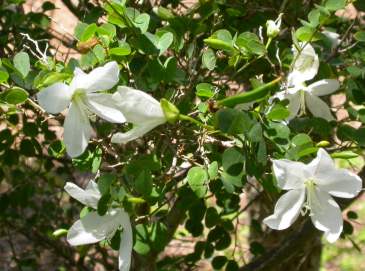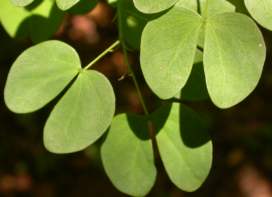Bauhinia natalensis
Bauhinia natalensis Oliv. ex Hook.
Family: Fabaceae
Common names: Natal bauhinia (Eng.); Natalsebeesklou (Afr.)
Introduction
This is a versatile, dainty shrub with butterfly-shaped leaves and pretty, white, maroon-striped flowers.

Description
Description
This lovely ornamental, rounded shrub is relatively fast growing and within a few years reaches its mature size of 2.5 x 3 metres.
The distinctively butterfly-like leaves consist of two rounded, almost completely divided, nearly semi-circular lobes and in Bauhinia natalensis they are delightful miniatures, being much smaller than any of the other South African species.

White, lightly fragrant, delicate, azalea-like flowers are borne in profusion — this plant can be almost completely covered with flowers for a long period throughout summer from November to April. The slightly crinkly oval petals are made all the more attractive by one of the petals having a red or deep pink centre stripe. The next two petals each has a lighter, thinner stripe and the other two are plain white.
The small fruit pods, 70 x 100 mm, are golden brown with pointed tips, borne from January to June; they split open when ripe, scattering the brown seeds.

Distribution and habitat
Distribution description
Found in valley bushveld and scrub. Distribution is restricted to the Eastern Cape and the southern KwaZulu-Natal coastal strip.
Derivation of name and historical aspects
History
The genus Bauhinia was established by Linnaeus in 1753 and honours the brothers Johan and Caspar Bauhin, both botanists and herbalists from the 16th century. They were identical twin brothers, so the name is quite apt as the characteristic paired leaves when folded together, are identical. The species name natalensis refers to the area where this species most commonly occurs.
The Afrikaans common name beesklou (cattle foot) is applied to most of the bauhinias and refers to the resemblance of the leaf to the footprint of cloven-hoofed animals.
Many of the almost 300 species of Bauhinia (orchid trees or camelsfoot) are popular garden subjects because of their decorative foliage and ornamental flowers and are widely grown in subtropical or tropical regions of the world. Some are used for their timber. Common to all members of this family are the two-lobed leaves, pod fruits and showy flowers. The common names of the genus refer respectively to the shape of the flower and the shape of the leaves which resemble a camel's foot when laid flat.
Most bauhinias are woody shrubs, some climbing with tendrils or scrambling, and some are small trees. The most commonly cultivated is the exotic Bauhinia variegata, the orchid tree, originally from India and China.
There are seven bauhinias that are indigenous to southern Africa , and all show horticultural promise. The most well known and widely cultivated is the pride-of-De Kaap, B. galpinii , bearing masses of bright orange-red flowers in summer. There is also the yellow bauhinia or bosbeesklou, B. tomentosa , a large shrub or small tree with bell-shaped yellow flowers; the Kalahari white bauhinia or koffiebeesklou, B. petersiana, a scrambling shrub or small tree with very crinkled white flowers. This species is divided into two subspecies, B. petersiana subsp. macrantha, which has broader petals, a smaller habit and occurs in the northwestern parts of South Africa, Namibia, Zimbabwe and Angola, and B. petersiana subsp. petersiana, which is usually a small tree and occurs in northeastern Zimbabwe, Mozambique and northwards; the Kei white bauhinia, B. bowkeri, a scrambling shrub with bunches of white flowers, is a rare endemic in the Transkei and Eastern Cape; and the pink bauhinia or sandbeesklou B. urbaniana, a shrub or bushy tree with rose-pink flowers from northeastern Namibia.
Ecology
Ecology
An interesting feature of this plant is that the leaves are adapted to close in response to reduced light. Caterpillars of the Common Emperor and the Banded Achaea moths feed on the leaves and flowers. Whitebellied sunbirds are regular visitors to the flowers.
Uses
Use
The great combination of foliage, flowers and the growth habit of Bauhinia natalensis offers makes it a plant with exceptional horticultural potential for any garden.
Three other species of Bauhinia are also used medicinally for everything from coughs, convulsions and constipation to pneumonia and venereal diseases ( Bauhinia galpinii, Bauhinia thonningii, Bauhinia petersiana).
Growing Bauhinia natalensis
Grow
Bauhinia natalensis will grow in full sun or in semi-shade. Once established it needs a moderate amount of water throughout the year and will tolerate almost any given rainfall. It is fairly sensitive to frost and will lose all its leaves if stressed, re-sprouting when conditions improve.
It is tolerant of a wide range of soils but seems to do best if planted in fertile, well-composted soil. If the soil is not that rich then feed regularly with a general fertilizer or apply a bi-annual dressing of compost and mulch before summer.
It is relatively fast growing and naturally neat so should require no pruning, although a light trim to gently shape it may occasionally be done.
Bauhinia natalensis can be grown beautifully as a solitary specimen, but has a lovely massed effect when grown in small groups of three or five. All the species of Bauhinia flower prolifically for long periods of time and the individual flowers are quite long-lived. Its multi-stemmed habit provides a suitable screen or it suits an informal shrub border. It has a very mild root system and can be used for growing against fences and walls.
Bauhinia natalensis is well suited to bonsai and, because of its size and habit, is perfect for the smaller garden or even for use in containers.
The seeds germinate easily and are best sown in spring. Germination should occur within two weeks; soaking the seeds in warm water overnight will speed up the germination process. Sow 1-2 mm deep in sandy, well-drained potting soil. To prevent pre- and post-emergence damping off, the seed should be treated with a fungicide prior to sowing, or watered with a fungicide immediately after sowing. After germination the seedlings should be potted up into individual bags/pots as soon as the first pair of true leaves appears. It may also seed itself freely in the garden, where the seedlings may also be dug up and transplanted into individual bags/pots as soon as the first pair of true leaves appears.
References
- Joffe, P. 1993. The gardeners guide to South African plants. Tafelberg, Cape Town .
- Joffe, P. 2001. Creative gardening with indigenous plants. Castle Graphics, Johannesburg .
- Joffe, P. 2003. Easy guide to indigenous shrubs . Briza Publications, Pretoria .
- Johnson, D. & Johnson, S. 1993. Gardening with indigenous trees and shrubs . Southern Book Publishers, Halfway House, Gauteng .
- Kruger, T.J. 1981. Trees, shrubs and climbers . Published by the author, Bethal , South Africa.
- Leistner, O.A. (ed.). 2000. Seeds plants of southern Africa : families and genera. Strelitzia 10. National Botanical Institute, Pretoria .
- Pienaar, K. 1991. Gardening with indigenous plants . Struik Timmins, Cape Town .
- Pooley, E. 1993. The complete field guide to trees of Natal, Zululand and Transkei . Natal Flora Publications Trust, Durban.
- Van Wyk, A.E. (Braam) & Van Wyk, P. 1997. Field guide to trees of southern Africa. Struik, Cape Town.
Credits
Cherise Viljoen
Kirstenbosch
February 2006
Plant Attributes:
Plant Type: Shrub
SA Distribution: Eastern Cape, KwaZulu-Natal, Mpumalanga
Soil type: Sandy, Clay, Loam
Flowering season: Spring, Early Summer, Late Summer, Autumn
PH: Neutral
Flower colour: White
Aspect: Full Sun, Morning Sun (Semi Shade), Afternoon Sun (Semi Shade)
Gardening skill: Easy
Special Features:
Horticultural zones









Rate this article
Article well written and informative
Rate this plant
Is this an interesting plant?
Login to add your Comment
Back to topNot registered yet? Click here to register.